by Romualdas Beniušis
Pajūrio najienos
Stella Maris-Marija. Mary, the star of the sea. That’s what the brothers Galidkas—priest Jurgis (1883–1963) and Lithuanian volunteer soldier Valentinas(1902–1966)—called the wooden chapel they paid for and built in Pašventys village on the banks of the Šventoji River. The Catholics of Šventoji, Būtingė and the surrounding area had no church of their own and they had to go to Palanga, Laukžemė or Darbėnai to attend church.
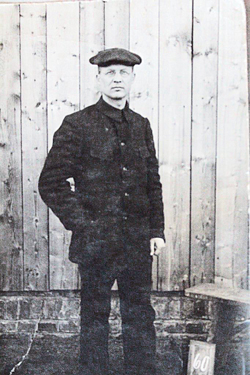
Galdikas in exile in Germany, ca. 1918
Jurgis Galdikas was born in Lazdininkai village in the Kretinga district in 1883 to the family of an average farmer. He went to school in Lazdininkai and the Darbėnai primary school, then the Palanga pro-gymnasium, and upon graduation chose to enter the priesthood and entered the Kaunas Priests Seminary. He was consecrated as a priest after being graduated in 1907, then continued to study theology in Austria, Belgium and Switzerland. He defended his thesis to become a doctor of philosophy in 1911. After returning to Lithuania he was the vicar in Šiauliai and was then appointed parish priest after the outbreak of World War I. He established and headed a gymnasium there. In 1916 the occupational regime of Kaiser’s Germany deported him with a group of Lithuanian priests to Germany where he spent two years. Returning to Lithuania in 1919, he was appointed director of the Kražiai pro-gymnasium, whose curriculum was based on etiquette, ethics and morality and which became the Žiburys gymnasium in 1924. He was sent to Telšiai in 1927 to become a canon of the capitulum (collegium) in the Telšiai diocese and from 1927 to 1932 he was a teacher and inspector at the Telšiai Seimnary.
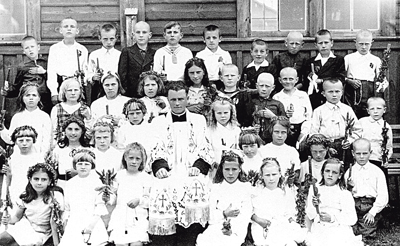
Children of Šventoji parish after first Communion ceremony with
father Antanas Račkauskas. A. Bagdonavičiūtė first on left in first
row, L. Bagdonavičiūtė second from left in second row.
At that time he had the idea to build a chapel on land his brother was granted as a volunteer soldier veteran, 8 hectares of the Būtingė manor estate which was divided up for such grants, next to his brother’s farmstead built in 1929 and 1930. The wooden chapel with a bell tower was built over the course of several months and cost 12,000 litas. Vincentas Borisevičius, rector of the Telšiai Seminary and future bishop and martyr (1887–1946), consecrated the building on July 12, 1931. The builders of the new chapel allowed parishioners from the Šventoji and Būtingė area to use it while a new Catholic church was being built in Šventoji.
After the chapel opened its doors, the foundations for a Šventoji–Pašventys parish were laid, and services were conducted on Sundays. As father Jonas Ilskis (1907–1985) served as vicar and chaplain at the church in Palanga from 1935 to 1938, he also organized the Šventoji parish and became the first administrator of the chapel, although the parish wasn’t established formally until 1939 with Lithuanian naval ship Prezidentas Smetona—then moored at the port of Šventoji—priest and military chaplain Antanas Račkauskas appointed administrator.
Aldona Bagdonavičiūtė-Jankūnienė, born in 1931 and resident now in Salantai, still has a photograph made by an unknown photographer in 1940 of Catholic children from the area after their first Communion ceremony together with father Račkauskas. The sisters Aldona and Laimutė Bagdonavičiūtė of Būtingė are among the children.
Father Galdikas and priest friends of his also performed Holy Mass at the chapel while vacationing at the farmstead, including Lithuanian Franciscan minister provincial Pranciškus Kazimieras Čepulis (1884–1962). Father Bernardas Talaišis (born 1929) from the same area who now works at the Franciscan Fathers monastery in Florida has said his family was invited to visit the Galdikas farmstead at the invitation of Čepulis when the latter was parish priest in Laukžemė and a good friend of the Talaišis family who lived just 2 kilometers east of there in Žyneliai village. Father Talaišis remembers they were fed sumptuously. Since many of the residents of the Šventoji and Būtingė area were fisherman who often risked their lives on the Baltic Sea during storms, most likely fahter Galdikas had the portrait of St. Casimir on the altar replaced in 1931 with an oil-on-canvas painting by renowned Lithuanian ecclesiastical painter Bronislovas Šaliamoras (1893–1976), “Virgin Mary, the Star of the Sea.” This painting portrays a small vessel full of people tossed about on a rough sea protected by the Virgin Mary, the Star of the Sea. It became much more than the centerpiece of the chapel, becoming a symbol of hope and salvation for those facing death. Chapel founder Jurgis Galdikas, the priests who served there and the congregation refused to remain apathetic to the plight of the Jews who had lived in the area since ancient times when the Nazis occupied Lithuania from 1941 to 1944 and attempted to drown them in a sea of blood and tears, even when the priests and parishioners faced equal danger and risk to their lives and those of their families.
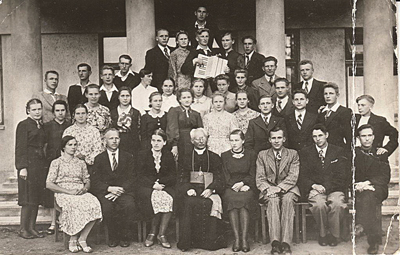
Jurgis Galdikas with members of the church choir in Veiviržėnai,
ca. 1941.
They had to choose whether to sacrifice for their fellow man to open their doors to him and share their breadth and their homes, or to remain observers, not to risk and to stay safe. Chapel visitors and residents of Būtingė Katerina and Benediktas Bagdanavičius made their decision immediately, and became the last hope for the Jewish women of Darbėnai. Their remote farmstead on the edge of the forest near the Lithuanian-Latvian border turned into a haven for the women of Darbėnai fleeing the Nazi genocide from 1941 to 1943, of whom four survived to see the end of the Nazi occupation. (Pajūrio najienos published accounts of what the Bagdanavičius went through in the Aril 15, 2017, and September 16, 2016, issues). On September 26, 2016, Lithuanian president Dalia Grybauskaitė posthumously awarded Katerina and Benediktas Bagdanavičius the Lithuanian order of the Life-Saver’s Cross for rescuing Jews during the Nazi genocide in World War II.
Following his service in Šilalė (1932–1938) and Palanga (1938–1941), father Galidkas was appointed parish priest of the church in Veiviržėnai and deacon of Švėkšna in 1941. He was there when the war found him on June 22, 1941. The German army occupied Veiviržėnai on the first day of the invasion and immediately began repressing the local Jewish community of 200. On June 28 local Jewish men were forced on trucks and taken towards Švėkšna, where they were murdered. After some time the remaining women and children were taken by cart to the old Trepkalnis manor near town. From there women were selected for labor in town and on various local farms. The local people attempted to help their Jewish neighbors with sympathy, food and clothing. Father Galdikas and father Antanas Zdanavičius, sensing in September of 1941 that the people impirsoned at Trepkalnis manor faced mortal danger, tried to rescue them through baptisms because the hope still smoldered that the Nazis would spare Jews who converted to Christianity. The town alderman also attempted to intercede on behalf of the Jews with the Nazi administration. Unfortunately the fate of the Jews had been decided long before by the Nazis, who planned to wipe them from the face of the earth. The Veiviržėnai rural district back then was part of the Kretinga district administratively and the executioners came from Kretinga, led by the chief of the Kretinga security police famous for his brutality, Pranas Jakys. On September 21, 1941, they murdered all of the people at the Trepkalnis manor and took their belongings—money, clothes, bedding, silverware—for themselves or sold them to buy vodka to relax after their “work.”
Only a few Jews of Veiviržėnai survived the mass murders. One of them was Fruma Pupsaitė (1924–1991), whom parish priest Galdikas sheltered on the eve of the mass murders in which her parents and ten brothers and sisters were killed. After some the Nazis and local collaborators began to suspect a Jewish girl was being hidden at the church, so a safer place with reliable people was found for her. From 1941 to 1944, Fruma Pupsaitė and her cousin from Veiviržėnai Ela Šliomavičiūtė, who also survived, were helped by a large number of local people who are unfortunately unknown, who disregarded risk to themselves and their families and gave the girls a roof, food and human warmth. Jurgis Galdikas remained parish priest in Veiviržėnai until 1953 when he became the parish priest in Klaipėda. He became an altarista (priest relieved of duties often due to old age) of the Šilalė church in 1956 and here celebrated the 50th anniversary of his priesthood in 1957. He died here in 1963 and was buried in the Šilalė town cemetery. On April 18, 2005, Lithuanian president Valdas Adamkus awarded him the order of the Life-Saver’s Cross.
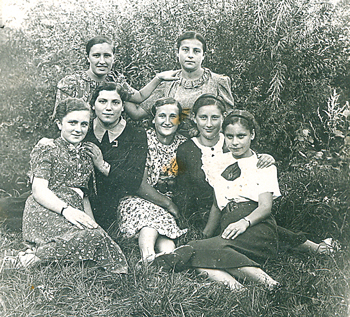
Just these two girls from Veiviržėnai survived: Fruma
Pupsaitė (second from right in first row) and Ela
Šliomavičiūtė (first on left). ca. 1939
Fruma Pupsaitė settled in Telšiai after the war and met Chaim Jakobas (born in 1925) there, whose father was a well-known businessman in town before the war and owned a number of automobiles and buses. The Soviets seized all except one vehicle after the occupation in 1940. This one automobile saved him and members of his family as they fled on the first day of the Nazi invasion into the USSR, altough the car was confiscated for the military on the Soviet border.
When he reached the age of majority in 1943, Chaim Jakobas was conscripted into the 16th Lithuanian Division of the Red Army and fought the Nazis and suffered the fortunes of war. He survived and the war ended when he was in Latvia. He continued to serve in the military in Vilnius until 1948 and afterwards returned to Telšiai.
Here he started a family with Fruma Pupsaitė. Their son Miša was born in 1949, then their daughters Zlata and Sima in 1951 and 1953. Miša, who completed high school in Telšiai, decided to become a teacher. In 1971 he completed higher teacher training studies.
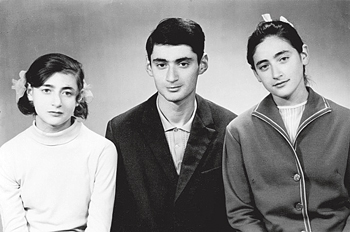
Sima, Miša and Zlata (right), 1965
He taught in Šiauliai and taught math in Plungė and then continued his career in Vilnius. In 1989 he began teaching math at the Sholem Aleichem high school in Vilnius and was school principal beginning in 1991. The school is now housed in renovated premises in the Žvėrynas neighborhood the Lithuanian capital and has 420 students of various ethnic backgrounds. Besides learning academic knowledge, the students are also inculcated with a sense of morality, tolerance and the duty to help others. There is no bullying at the school. “Children should be happy at school,” principal Miša Jakobas often says.
And so the chapel of the village of Pašventys on the banks of the Šventoji River, born in the spirit of the charity and aid of stella maris, helped people survive when they faced death, and to live on and thrive, traveling around the world, and that journey has no end…

